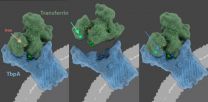(Press-News.org) (SALT LAKE CITY) - Examination of DNA from 21 primate species - from squirrel monkeys to humans - exposes an evolutionary war against infectious bacteria over iron that circulates in the host's bloodstream. Supported by experimental evidence, these findings, published in Science on Dec. 12, demonstrate the vital importance of an increasingly appreciated defensive strategy called nutritional immunity.
"We've known about nutritional immunity for 40 years," says Matthew Barber, Ph.D., first author and postdoctoral fellow in human genetics at the University of Utah. "What this study shows us is that over the last 40 million years of primate evolution, this battle for iron between bacteria and primates has been a determining factor in our survival as a species." The study also models an approach for uncovering reservoirs of genetic resistance to bacterial infections, knowledge that could be used to confront emerging diseases.
Following infection, the familiar sneezing, runny nose, and inflammation are all part of the immune system's attempts to rid the body of hostile invaders. Lesser known is a separate defense against invasive microbes, called nutritional immunity, that quietly takes place under our skin. This defense mechanism starves infectious bacteria by hiding circulating iron, an essential nutrient it needs for survival. The protein that transports iron in the blood, transferrin, tucks the trace metal safely out of reach.
Clever as it sounds, the ploy is not enough to keep invaders at bay. Several bacterial pathogens - including those that cause meningitis, gonorrhea, and sepsis - have developed a weapon, transferrin binding protein (TbpA), that latches onto transferrin and steal its iron. Though scientists have known of the offensive strategy, they failed to realize how pivotal the battle over iron has been in the conflict between host and pathogen.
"Interactions between host and pathogen are transient and temporary," says senior author Nels Elde, Ph.D., assistant professor of human genetics at the University of Utah. "It took casting a wide net across all of primate genetic diversity to capture the significance."
Just as details of a struggle can be gleaned from battle scars, Barber and Elde reconstructed this evolutionary conflict by documenting when and where changes in transferrin and TbpA have occurred over millennia. They examined the DNA of transferrin in 21 species from the primate family tree, and of TbpA from dozens of bacterial strains. The majority of accumulated changes in transferrin and TbpA cluster around a single region of contact between the two proteins, highlighting it as a site of evolutionary conflict between host and pathogen. The authors then used these genetic observations as a guide to perform experiments, which showed changes in TbpA enable the protein to grasp hold of transferrin, and that recent changes in transferrin allow it to evade TbpA.
Up to 25 percent of people in the world's populations have a small alteration in the transferrin gene, which prevents recognition by several infectious bacteria, the most recent sign of this long battle. "Up until this study no one had come up with a functional explanation for why this variation occurs at an appreciable frequency in human populations," says Elde. "We now know that it is a consequence of the pathogens we and our ancestors faced over millions of years."
VIDEO:
When bacteria that cause infectious diseases invade, the host starves the bacteria by hiding circulating iron, an essential nutrient it needs for survival, within the folds of a protein called...
Click here for more information.
Understanding the strategies that underlie natural defense mechanisms, including nutritional immunity, could inform new approaches to combatting antibiotic-resistant bacteria and emerging diseases. "By examining the natural conflicts that have played out for millions of years, we can determine what has worked, and apply them in new situations," says Elde.
INFORMATION:
Escape from iron piracy through rapid evolution of transferrin. MF Barber, NC Elde, Science Dec 12, 2014
The work was supported by awards from the Pew Charitable Trusts and the National Institutes of Health
How birds evolved to have characteristics including feathers, flight and song is revealed with new clarity in a major study of their family tree.
The international study charts a burst of evolution that took place after the mass extinction of dinosaurs, 66 million years ago. This step-change gave rise to nearly all of the species of birds that we see on the planet today - more than 10,000 varieties.
The four-year project - which included researchers from the University of Edinburgh's Roslin Institute - decoded and compared the entire genetic fingerprint of 48 bird species. ...
Two penguin genomes have been sequenced and analyzed for the first time in the open access, open data journal GigaScience. Timely for the holiday season, the study reveals insights into how these birds have been able to adapt to the cold and hostile Antarctic environment.
Antarctic penguins are subject to extremely low temperatures, high winds, and profound changes in daylight. They have developed complicated biological systems to regulate temperature and store energy for long-term fasting. Most studies have focused on the physiological and behavioral aspects of their ...
DURHAM, N.C. -- His office is filled with all sorts of bird books, but Duke neuroscientist Erich Jarvis didn't become an expert on the avian family tree because of any particular interest in our feathered friends. Rather, it was his fascination with how the human brain understands and reproduces speech that brought him to the birds.
"We've known for many years that the singing behavior of birds is similar to speech in humans -- not identical, but similar -- and that the brain circuitry is similar, too," said Jarvis, an associate professor of neurobiology at the Duke ...
VIDEO:
A microscopy system continuously measures responses to signaling chemicals in thousands of cells at a time.
Click here for more information.
Scientists have discovered a general principle for how cells could accurately transmit chemical signals despite high levels of noise in the system, they report in Science this week.
A cell's response to outside chemical signals depends on its physiological state, which can fluctuate considerably. Amounts of different kinds ...
The entire semiconductor industry, not to mention Silicon Valley, is built on the propensity of electrons in silicon to get kicked out of their atomic shells and become free. These mobile electrons are routed and switched though transistors, carrying the digital information that characterizes our age.
An international team of physicists and chemists based at the University of California, Berkeley, has for the first time taken snapshots of this ephemeral event using attosecond pulses of soft x-ray light lasting only a few billionths of a billionth of a second.
While ...
CHAMPAIGN, Ill. - Where did the songbird get its song? What branch of the bird family tree is closer to the flamingo - the heron or the sparrow?
These questions seem simple, but are actually difficult for geneticists to answer. A new, sophisticated statistical technique developed by researchers at the University of Illinois and the University of Texas at Austin can help researchers construct more accurate species trees detailing the lineage of genes and the relationships between species.
The method, called statistical binning, was used in the Avian Phylogenetics Project, ...
This news release is available in Spanish. 66 million years ago, the dinosaurs, as we think about them, became extinct, but certain reptiles and birds survived this mass extinction. The birds that survived experienced rapid evolution and diversification. Until now, explaining the family tree of modern birds has been a difficult and controversial subject amongst scientists. Thanks to the research of an international consortium involving researchers from the Centre for Genomic Regulation in Barcelona, we now have new clues about this evolution and further information ...
FORT LAUDERDALE-DAVIE, Fla. - We all know that ducks, crows, falcons and egrets are birds. A group of scientists, however, wanted to dig deeper and unlock more about how these animals are related genetically. The idea was to investigate how modern species of birds emerged and evolved after the dinosaurs disappeared from the earth. This research included work from Stephen O'Brien, Ph.D., a professor at NSU's Oceanographic Center whose main focus in genomics.
Now findings from this research are being announced in several scientific publications, including Science magazine, ...
A Texas Tech University biologist led a team of more than 50 scientists who mapped the genomes of three crocodilians.
By mapping these genomes, scientists may better understand the evolution of birds, which are the toothy predators' closest living relatives, said David Ray, an associate professor of biology. The team completed genomes of a crocodile, an alligator and a true gharial to complete the genomic family portrait.
Their research, largely funded by the National Science Foundation, will appear Friday (Dec. 12) in the peer-reviewed journal, Science.
"One of the ...
Scientists from Nanyang Technological University (NTU) have discovered exactly how the malaria parasite is developing resistance towards the most important front-line drugs used to treat the disease.
Malaria is a mosquito-borne parasite which affects over 60 million people worldwide and in serious cases, can be fatal. There is currently no viable vaccine for malaria while antimalarial drugs and prophylaxis are losing its efficacy with increasing drug resistance.
NTU Associate Professor Zbynek Bozdech, who led an international research team from 11 different countries, ...






